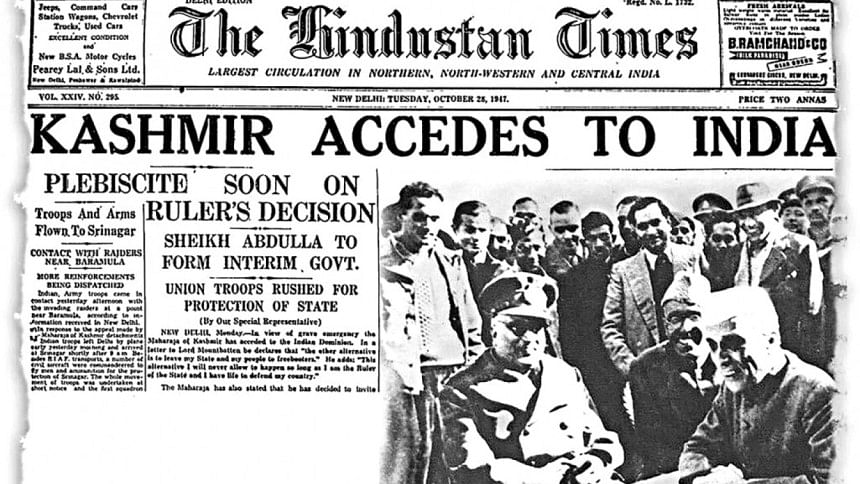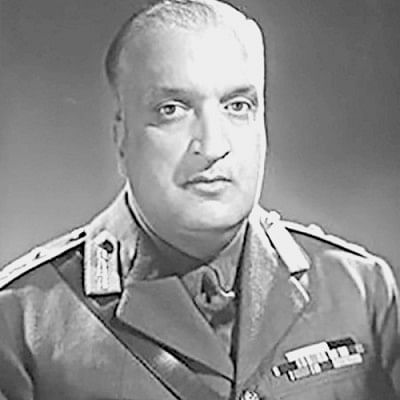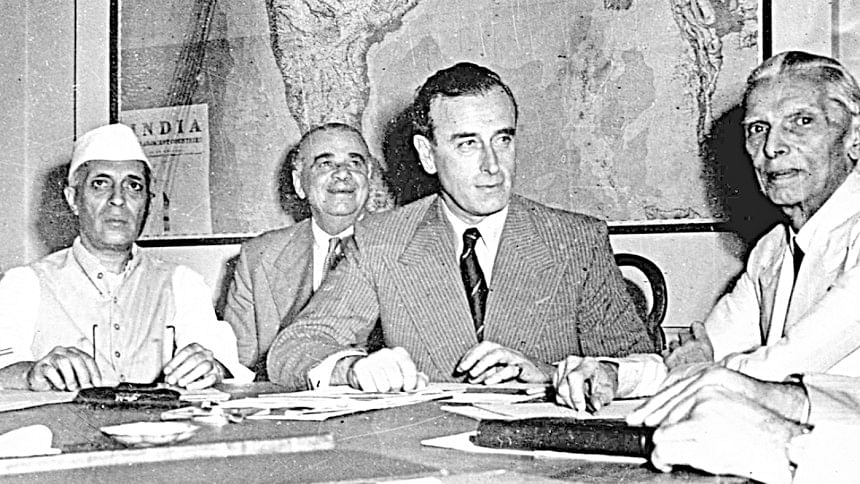KASHMIR CONFLICT SINCE PARTITION

FORMATION OF KASHMIR: The Princely State of Jammu and Kashmir (J&K), was formed in 1846 under the Treaty of Amritsar signed between the East India Company and Maharaja Gulab Singh. The Maharaja became the founder of the Royal Dogra Dynasty and the first king of the Princely State of Jammu and Kashmir by paying 7.5 million of Nanak Shahi rupees (the ruling currency of the Sikh Empire) to the British government and bought Kashmir Valley, Ladakh Wizarat (comprising of Baltistan, Kargil and Leh) and added it to Jammu which was already under his rule. Gilgit Wizarat (comprising of Gilgit and Pamiri areas) were conquered later in the war against Sikh rule led by Dogra Generals.
PARTITION AND THE BEGINNING OF CRISIS : In 1947, after much turmoil, India and Pakistan gained independence from British Empire. 562 Princely States existed in British India before the partition, which were not completely and formally part of British India. Under the hasty terms of partition, the princely states could decide to join either new nation or remain independent. Hari Singh, the then Maharaja of Kashmir, choose to remain independent. He offered to sign Standstill Agreements with both India and Pakistan. Pakistan immediately signed it while India asked for further discussions on its contents. But the discussion never took place.
Soon after the Standstill Agreement, as partition-related violence raged across the two new nations, the government of Pakistan pressured Kashmir to join it. Pro-Pakistani rebels took over much of western Kashmir, and in September 1947, Pashtun tribesmen streamed over the border from Pakistan into Kashmir carrying out killings and arsons. The panic-stricken maharaja asked for India's help in staving off the invasion, but India responded that, in order to gain military assistance, Kashmir would have to accede to India, thus becoming part of the new country. Singh agreed and signed the Instrument of Accession in 26 October 1947.

The Governor General of India Lord Mountbatten accepted the Accession of Jammu and Kashmir with a remark, "It is my government's wish that as soon as law and order have been restored in Jammu and Kashmir and her soil cleared of the invader, the question of the State's accession should be settled by a reference to the people".
FIRST KASHMIR WAR AND 'CEASEFIRE LINE': Consequently to the signing of the Instrument of Accession, the first war was fought between India and Pakistan over the Jammu and Kashmir from 1947 to 1948. This led to more unrest and the United Nations had to intervene to negotiate a cease-fire. Most troops were withdrawn and a Ceasefire Line was mutually agreed upon between India and Pakistan in January 1949.
Article 370 and special status: The Instrument of Accession grants the state of Jammu and Kashmir federal autonomy within the Union of India except Defense, Central Finance, Communications and Foreign Affairs. In 1948, mass leader of Jammu and Kashmir, Sheikh Abdullah became the prime minister of Jammu and Kashmir and in 1949, Sheikh Abdullah and Maharaja Hari Singh agreed that Jammu and Kashmir should remain united with India with the maximum possible autonomy. A special status was given to the state by the Indian Constitution under Article 370 and in 1951, the first elections for the J&K Constituent Assembly were held which later elected a body of representatives to formulate the Constitution of Jammu and Kashmir. On 14th July 1954, the Constituent Assembly of Jammu and Kashmir decided that Article 370, which was temporary in nature shall remain in force, making it in essence a permanent feature of the Indian Constitution. The Constituent Assembly of J&K State had the legal authority to recommend the articles of the Indian constitution to be applied to the state or to abrogate Article 370 altogether. With the dissolvement of the Constituent Assembly in 1957, Article 370 became un-amendable. In October 2015, the High Court of Jammu and Kashmir has ruled that Article 370 cannot be "abrogated, repealed or even amended". It explained that clause 3 of the Article conferred power to the State's Constituent Assembly to recommend to the president on the matter of the repeal of the Article. Since the Constituent Assembly did not make such a recommendation before its dissolution in 1957, Article 370 has taken on the features of a "permanent provision" despite being titled a temporary provision in the Constitution. The arguments in favor and against abrogation of article 370 are both debatable, however legal experts say it cannot be abrogated as it would translate into fundamentally changing the Instrument of Accession.
UN mediation in Kashmir and plebiscite: The UN Security Council adopted its first resolution, 39, on 17th January, 1948, and United Nations Commission for India and Pakistan (UNCIP) was established. On 21st April, 1948, Resolution 47 was adopted. Besides cessation of hostilities and withdrawal of all troops, UNSC called for a UN supervised Plebiscite in the Princely State of Jammu and Kashmir under a Plebiscite Administrator to determine the aspirations of the people. In January 1949, another resolution was laid down citing requirements for holding a Plebiscite, one of which was Pakistan withdrawing its troops from that area. Till date Pakistan has failed to implement its clauses.
India-Pakistan 1965 War: The Kashmir conflict resumed in the India-Pakistan War of 1965. The Pakistani army tried to take Kashmir by force but failed. The Security Council passed a resolution to put an end to the fighting and ban arms supplies to both parties.
The Shimla Agreement: The Shimla Agreement was signed between India and Pakistan in 1972 to bring peace between the two countries after the Bangladesh Independence War. Another line of control was established between Indian-controlled Kashmir and Pakistan-controlled Kashmir. Both countries agreed to put an end to the conflict and confrontation, and adjudicate their differences by peaceful means through bilateral negotiations without any third-party intervention. The signing of the agreement essentially made Jammu and Kashmir dispute a bilateral one.

Kashmir Accord (1975): The Kashmir Accord (February 1975) was signed between Indira Gandhi and Sheikh Abdullah. The Accord strengthened India's role over legislation in Kashmir, though the state continued to be governed by Article 370 of the Indian Constitution. It was agreed that, residuary powers of legislation shall remain with the State but Parliament of India will continue to have power to make laws relating to the prevention of activities directed towards disclaiming, questioning or disrupting the sovereignty and territorial integrity of India or bringing about secession of a part of the territory of India from the Union. In 1977, the Congress party of the state withdrew its support in favor of the Abdullah government, ending the National Conference-Congress Alliance. In retaliation, Abdullah began supporting a demand for Plebiscite.
Mass violence and exodus of Hindus: Jammu and Kashmir witnessed sporadic periods of violence post the Independence of India, but never an organized insurgency till 1989. Tens of thousands have been killed by violence in Indian-controlled Kashmir since 1989. In response, India imposed direct rule in 1990, which worsened the situation, resulting in violent attacks on Hindu residents. 100,000 Kashmiri Hindus (Pandits) fled the valley, fearing for their lives.
Kargil conflict: The Kargil conflict of 1999 erupted when India launched air strikes against Pakistan-backed troops that had infiltrated Indian-controlled Kashmir. Pakistan refused to claim responsibility for the infiltration, but was forced to call back its troops under pressure from the United States. Pakistan was also suspended from the Commonwealth.
The Uri Attack: After years of relative peace, tensions were reignited when armed militants attacked the Indian army base in Uri, killing 18 soldiers. India responded by blaming Pakistan, while Pakistan blamed India for the unrest in the region.
Human Rights Violations: In 2016, The Indian army killed Burhan Wani, a 21-year-old commander of the separatist group Hizbul Mujaheedin. This led to massive protests that resulted in curfews and lockdowns in large parts of the region. The Indian army used pellet guns to disperse the angry crowd, blinding hundreds. The New York Times called it an epidemic of "dead eyes".
Scrapping of Article 370: On august 4, the Indian government stripped Kashmir of the special autonomy it has had for seven decades. Prime Minister Narendra Modi's Hindu-nationalist party rushed through a presidential decree to scrap from the constitution the Indian-ruled part of the disputed territory's special status. It also moved a bill proposing the Indian-administered part of Kashmir be divided into two regions directly ruled by New Delhi. Ahead of the announcements, tens of thousands of extra Indian troops were deployed in the territory, and a security lockdown was imposed with all telecommunications there cut.
What Kashmiris want: Though India and Pakistan are both claiming the whole of Kashmir as their integral part, nearly 90 percent of Kashmiris in summer capital of Srinagar want independence, according to a 2007 poll published by Indian Express. 87 percent of people questioned in Srinagar had no allegiance to either side. Only 3 percent of the mainly Muslim inhabitants of the city think Kashmir should become part of Pakistan, and 7 percent prefer Indian rule, the poll said. But down in Jammu, the state's mainly Hindu winter capital in the plains to the south, 95 percent think Kashmir should be part of India. Both countries claim the region in full, and both have ruled out independence as an option. India controls around 45 percent of the former princely state, Pakistan around a third and China the rest, a largely uninhabited slice of high-altitude desert.

 For all latest news, follow The Daily Star's Google News channel.
For all latest news, follow The Daily Star's Google News channel. 



Comments